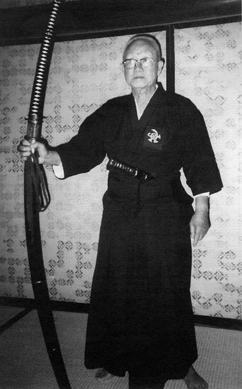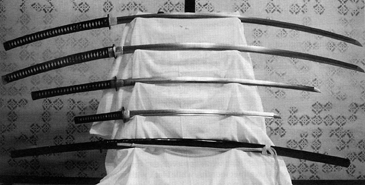

In writing about the Kage-ryu, I should first explain that it has no connections with any other Kage or Shinkage-ryu. There are in all only a handful of people practicing this particular ryu-ha as it is described in the scrolls and manuscripts, all of whom live in Japan. It is the last surviving style of authentic long-sword (choken) in Japan.
In looking at the kanji for kage, readers will observe that it reads keshiki, meaning a view or scene. This is the original kanji for the ryu-ha and has not been changed since the tradition’s inception in the mid-sixteenth century.
The founder of Kage-ryu was Yamamoto Hisaya Masakatsu of Akizuki, a part of present-day Amagishi, Fukuoka prefecture. Next to Akizuki is Kasuya-gun, the home of the first generation of the Tachibana family, who succeeded him as leaders of the ryu. The famous Lord Tachibana Muneshige moved the second generation of his family to form a fief in Yanagawa in 1590. The present location of the old Yanagawa domain is Yanagawa City, and there the Tachibana line remains unbroken to this day. Although Yanagawa castle is long gone, the family still preserves many precious treasures, documents, and traditions that have been passed down through seventeen generations. The current Tachibanas own a hotel, and maintain on its grounds a period mansion, Japanese gardens, and a Hall of History. Within the buildings are some old, original maps of the castle, moat, and surrounding houses where the retainers lived. On reading the maps one can find the family name of one current member of the ryu, Takamuku Miyoji, director of the Kyu Yanagawa Han Kobudo Shinkokai.

The Tokugawa Shogunate standardized the size of swords in Japan to what is commonly called josun, or in written form, teisun, meaning designated length. This was two shaku three sun (69.7 cm) [a shaku is about equivalent to a foot, while a sun is just a fraction less than one inch]. In order to maintain better control of the country the shogun would frequently arrange for a loyal clan to keep an eye on another, perhaps more independent, domain. Thus, the lords of neighboring Nabeshima, now Saga city, policed Yanagawa for the shogunate. Although Saga City is only a thirty-minute car ride, or perhaps forty minutes on horseback from Yanagawa, there was no love lost between these clans! Even though supervising visits were paid to ensure that the Tokugawa laws were being observed, it seems that the Kage-ryu successfully kept its secret long enough for it to become the last surviving long-sword style in Japan.
Kage-ryu was and is still to this day otome-ryu, literally “that which flows but remains at home,” a term used to refer to schools that were officially associated with a particular domain or fief. Another term used to describe such a school is mongai-fushutsu, which means “not to be shown outside.” One may think it rather sad that entry into the ryu-ha and its teachings are restricted, but it is this restriction that has allowed the tradition to remain unchanged whilst other long-sword styles have long since disappeared or have been changed by succeeding practitioners to the extent that they no longer resemble their original form.
The Kage-ryu Today
The Kage-ryu pledges allegiance to the present 17th generation head of the Tachibana family. Therefore titles or dan ranks are unnecessary to maintain its lineage. The ryu is led by a democratically elected shihan. Other members are known as kaiin, meaning simply “members.” These members do have dan grades in other martial arts and were permitted to enter the Kage-ryu based on these grades and experience.

The “minimum length” for blades used in the Kage-ryu is two shaku eight sun (84.8 cm), five inches longer than the length prescribed by the shogunate. At the present time the shortest blade being used is well over this length, and my wife uses a blade measuring three shaku two sun (97 cms), while the longest measures four shaku (121.2 cms). In comparison to these lengths, the blade of the famous Sasaki Kojiro [said to have been killed in a duel with Miyamoto Musashi, who used a bokken he had carved from a boat oar] was reputed to be three shaku one sun.
Only live blades are used in the Kage-ryu! However, for beginners, for learning new techniques, and for reasons of safety when using such long weapons in confined spaces weapons known as sayasui-bokken [bokken with a saya] are sometimes used. The size and length of the tsuka or hilt varies as it is, of course, made to suit the reach and requirements of its user. The longest tsuka at this time is two shaku, giving the sword an overall fitted length of five feet ten inches (178 cms).
Having a sword made could be perhaps likened to having a suit of clothes tailored. The sword is made to fit the user. A sword differs from a suit of clothes in that it is not only worn but used. Bearing this in mind, the Yanagawa swords vary also in balance and weight according to the individual. The heaviest one in use at the moment is my sword, which weighs just over seven pounds (3.25 kg).
Although combat techniques as used on horseback are practiced, the swords used nowadays are not carried slung at the side of the body like a tachi, but are angled across the front and inserted in the belt. A tanto, known as a maezashi in Kage-ryu, is worn across the front of the body. It is used for throwing or in close quarter encounters, where another person would grapple with the swordsman to prevent him from drawing his longer sword.
There are sixteen basic forms still practiced. Within each form are many variations and individual techniques. Each form can be done in tate-hiza (crouched position), standing, drawing the sword with either left or right leg forward, turning to either side or to the rear, turning in both directions, etc. There are some interesting one-legged stances, including the sagi-ashi (heron leg). Cuts can be made to many different parts of the anatomy. Thus, techniques are varied and endless.
Like most classical styles, the emphasis is placed first on fast practicality rather than prettiness. Keikaeshi (jumping leg reversal) is frequently used within the forms, as Kage-ryu was used to fight while wearing armor (yoroi). Over the years, the stance in many other styles has become more upright and straight to suit indoor requirements. The problem with this is that anyone trying to cut something using a high stance with no hip movement will succeed more by luck than judgment. Stances in Kage-ryu are practically low and long to ensure stability on uneven ground and to take advantage of the tremendous power generated from a low hip position such as is used in sumo.
There is no seated technique in Kage-ryu. This again is for practical reasons. Many years ago, if anyone went into another person’s house wearing a long weapon it was not to sit down and drink tea!
Training is rigorous. In the Kage-ryu exponents are encouraged to study more than just swordsmanship, and practice other traditional arts. Demonstrations of the Kage-ryu include shakuhachi, shigen (Japanese singing), and the mikkyo (esoteric signs) and horagai (conch shell) of Hongan-Shuken-Sho (a school of shugendo, or yamabushi practices from Kyoto). Training naturally extends into one’s daily routine. All budo, and even Japanese sports, have their spiritual aspects. However, in thirty years of enjoyable study in various arts and groups I have until now not found another ryu-ha with a more family-like attitude.
Black hakama and uwagi are worn for everyday practice. White uwagi are worn in warmer months, while black with short pants under the hakama are worn in winter. Kaiin are entitled to wear the kamon (family crest) of the Tachibana clan, known as Gion Mamori, a design of intertwined ginko leaves. For formal events montsuki-hakama [formal clothing emblazoned with the family crest] of the Tachibana clan are worn by kaiin.
Although the Kage-ryu is not in itself a part of any religious order, it does strictly adhere to religious convictions on a traditional family basis. The Tachibana family has a shrine dedicated to them where they and the Kage-ryu observe and always participate in religious events.
Finally, I should mention one other ryu-ha in the area, the Oishi Shinkage-ryu. Its founder, Oishi Susumu, was a retainer and swordmaster of the Tachibana clan. He was said to be five foot eleven inches tall (1.8 meters), a great height for a Japanese of his day. There are stories of him engaging in combat around Japan using his four shaku shinai (121.2 cms) [see, for example the article on Chiba Shusaku in AJ100]. It has been said that one reason the size of the shinai was standardized was partly in connection to this weapon. Perhaps some of the opponents he defeated considered it to be an unfair advantage. Oishi Susumu lived in Yanagawa’s Mike-han, now Ohmuta-shi, also the home of the present generation of the Oishi family. One of the family is the same height as his ancestor. The present sixth generation headmaster of Oishi Shinkage-ryu is Oishi Eichi Sensei. He is of normal Japanese stature, and jokingly says that somewhere along his family tree the genes must have got mixed up! Oishi Shinkage-ryu uses swords and saesui bokken of a standardized two shaku eight sun.
Copyright ©1995 Colin Hyakutake. All rights reserved.
This article first appeared in Aikido Journal #104, 1995.
